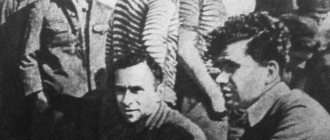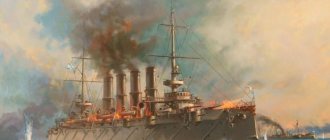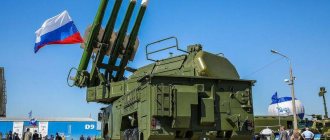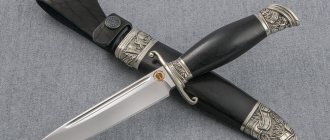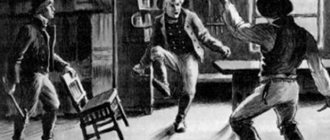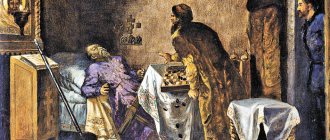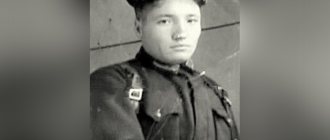Currently, the concept that the NKVD was a punitive organization, the main function of which was to identify and shoot the best representatives of the Soviet army, is firmly rooted in the minds of residents of the CIS. This is also facilitated by modern filmmakers who paint the image of an evil and vindictive security officer, who, out of personal hostility, destroys valiant commanders, bringing them under execution.
There are many legends about the NKVD, the main one of which is that all sorts of SMERSHists only prevented normal soldiers and officers from fighting, delaying the desired moment of victory. And after the victory over Nazi Germany, the NKVD troops diligently identified enemies of the people, who were declared to be almost all prisoners of war. Whether this is true or not, let's try to figure it out.
Operational troops of the NKVD
The internal troops of the NKVD had certain tasks that they dealt with first. These included:
- The fight against banditry. Moreover, this meant both criminal and political banditry;
- The fight against accomplices of such gangs. It was from this time that the NKVD regiments acquired the bad reputation of bloody executioners, because the bandits’ accomplices were often their relatives, who were civilians;
- The commanders of the NKVD regiments supervised operations to identify, detect, pursue and destroy all illegal gangs on the territory of the country.
From 1934 to 1941, the main tasks of the NKVD regiments were to assist border guards and internal troops. In 1941, by a special order of the NKVD of the RSFSR, all these regiments were reorganized into internal troops.
After the Great Patriotic War began, the NKVD troops received additional powers:
- They began to be brought in to guard the rear;
- Serving in garrisons that were located in settlements liberated from enemy forces;
- In 1943, NKVD regiments were supposed to be engaged in the construction, restoration and protection of government communication lines;
- Special purpose brigades and radio intelligence of the NKVD also became part of the internal troops.
Naturally, in the process of specialized operations, the NKVD had to use not entirely humane methods of obtaining testimony, so the stories about how women were tortured in the NKVD are not without foundation.
Behind enemy lines
If you look at the list of awarded NKVD employees during the Great Patriotic War, then most often in the line “place of service” there will be “OMSBON NKVD”.
A separate motorized rifle brigade for special purposes of the NKVD was subordinate to the famous intelligence officer and saboteur Pavel Sudoplatov, and its task since 1942 was to train detachments for operations behind enemy lines. D. Medvedev’s detachment operating near Rivne consisted of fighters from the “special brigade”, who had previously fought as part of ski detachment No. 4/70 in the winter of ’42. And in the fall of 1941, this brigade fought on the outskirts of Moscow.
D. Medvedev in a partisan detachment (photo source)
“The political instructor of the detachment, Nikolenko, was surrounded in the forest and after a long struggle, having destroyed eight Germans, he was grabbed from behind and taken prisoner. But since the pistol was not taken away from him, he shot the guard and, after long wanderings behind enemy lines, came out and ended up in the hospital in the village of Naumovo.”
“A detachment group of 35 people, under the command of Captain Vasin with 25 people attached to the detachment. drivers of the 10th Army defended the village of Popkovo.
23.1.42 at 10.20, five tanks appeared on the road from Bryn to Popkovo, followed by infantry and a convoy.
The squad prepared for battle. The existing anti-aircraft gun opened fire on the tanks with direct fire, two mortars found by Vasin were adapted for firing and also opened fire. Enemy tanks, firing their guns, approached the village and set fire to the houses in which the detachment’s fighters were defending.
The gun and mortars were discovered and destroyed by enemy tanks. The soldiers of the detachment threw grenades at the tanks and knocked out one of the tanks that entered the village, the rest fired at the houses (they set fire to 12-13 houses) and returned to the suitable infantry units with a battalion force armed with automatic weapons and mortars. Four enemy tanks, having planted machine gunners, brought them to the south. env. Popkovo and dropped off. A battle ensued with the fighters of Vasin’s detachment defending the house.
Of the four tanks that entered, another tank was hit and one tank was set on fire. Despite the enemy's superiority of forces and resources by several times (10-15 times) and the enemy's outflanking maneuver on the right, the detachment continued to fight for 4.5-5 hours. As a result of the battle, the detachment destroyed up to 100-110 Germans. The detachment lost six people killed, one wounded and 13 missing. Captain Vasin himself and the commissar, political instructor Utyashev, were killed.”
Soldiers of the separate special purpose motorized rifle brigade (OMSBON) prepare for battle (photo source)
NKVD troops and their structure
At the beginning of 1941, the NKVD authorities were divided into two departments, the NKVD and the NKGB. The NKVD organs, in turn, were now divided into four main departments. Each group was responsible for its own area:
- The first group fully ensured the internal security of the USSR. It included police, firefighters, air defense, prison guards and other similar services;
- The second group dealt exclusively with camps on the territory of the USSR. These departments of the NKVD supervised the Gulag, large-scale construction projects in the country, the development of the North, and so on;
- The NKVD bodies, which belonged to the third group, were engaged in economic, administrative, financial, personnel and other similar activities, ensuring the smooth functioning of the NKVD of the RSFSR;
- NKVD troops of the fourth type belong to the so-called internal type. The NKVD military officers who served in these troops are the same legendary “bloody” security officers.
The NKVD bodies belonging to the latter type included the following units:
- Main Directorate of Border Troops;
- NKVD troops protecting railway structures. These NKVD regiments were also supposed to protect strategically important enterprises for the country;
- Directorate of Convoy Troops;
- Department of Propaganda and Agitation;
- Military supply and military construction department.
The NKVD of the RSFSR was not particularly popular among the people even before the war, and during the Second World War, when the heads of the bodies received almost unlimited power, they completely became a punitive body.
Creation and scope of activity
The NKVD was formed in 1934 . The scope of activity of this commissariat was quite extensive. His competence included:
- management of construction, housing and communal services and other industries in a supervision format;
- registration of civil status records (CVR);
- identification of political criminals . Note: the People's Commissariat was given the right to accuse and carry out punishment without trial;
- ensuring public order and fire safety;
- protection of state and personal (not to be confused with private) property;
- management of the penal system (prisons, colonies, camps);
- carrying out foreign reconnaissance (collecting information about potential external enemies);
- protection of the state border (border troops);
- counterintelligence (suppression of espionage activities).
It is obvious that one government agency could not cope with such a huge number of delegated functions. Therefore, within the framework of the NKVD, many organizations were created , each of which was engaged in performing certain tasks:
- Main Directorate (GU) of State Security;
- Main Directorate of Police;
- Main Directorate of Border and Internal Security;
- Fire Department;
- State Administration of Correctional Camps (GULAG);
- MARRIAGE REGISTRY;
- structures that provide the economic and financial basis for the activities of the listed departments.
Leaders of the NKVD in different periods:
- 1934-1936 – G. Yagoda;
- 1936-1938 – N. Yezhov;
- 938-1945 – L. Beria;
- 1945-1946 – S. Kruglov.
Note: the fate of the listed commissioners (except for Kruglov) is quite sad. All of them were shot.
In 1946, the commissariat was transformed and renamed the Ministry of Internal Affairs (Ministry of Internal Affairs) . The functions of protecting state security, starting in 1941, were transferred several times to a separate department and returned back.
And only in 1954 these responsibilities were finally delegated to a special government structure - the State Security Committee (KGB) .
You can read more about dates and milestones on Wikipedia at this link.
NKVD bodies in intelligence and counterintelligence
Despite the fact that Soviet counterintelligence has been constantly slinging mud recently, in fact, the intelligence officers of the NKVD of the RSFSR were among the best in the world. Reconnaissance during any war is a very powerful tool for influencing the enemy. Thanks to scouts, you can find out information about the current state and plans of the enemy, and then deliver an accurate and fatal blow.
Counterintelligence protects the country from similar actions by its opponent. In world practice, there are many examples of how one single saboteur was able to inflict damage on a country that far exceeded the damage caused by an entire division.
As for the NKVD’s “hunt” for deserters and morally weak people in the army, unfortunately, there are such soldiers in every army. One alarmist among the soldiers can lead to the desertion of the entire unit, and traitors in the command staff can lead to the loss of the entire military operation.
It was for this reason that employees of the NKVD of the RSFSR carried out systematic work to identify such sentiments in the army. According to the laws of war, identified traitors were punished very harshly. There have been cases of unfair accusations, but it is better to be safe than to risk thousands of lives.
Since the war took the Red Army almost by surprise, by October 1941 the NKVD authorities had detained more than 650,000 Red Army soldiers and their commanders who, for whatever reason, lagged behind their units or simply deserted. Although many believe that the NKVD executed most of them, only 25,000 were arrested. The rest were simply sent to the front line to atone for their guilt with blood. Even out of 25,000 arrested, about 10,000 people were shot.
Among those executed, about 1,500 spies and about 300 saboteurs were identified. Most likely, no more than half of this number were real spies. But since the people's commissars and heads of the NKVD demanded immediate results, no one conducted detailed investigations, and executions were often too cruel a measure.
Counterintelligence was also involved in work outside the Red Army units. Employees of the NKVD department trained their saboteurs and were engaged in sending operational groups into territories occupied by the enemy. It is now believed that the famous partisan movement arose thanks to popular self-awareness, but in fact, most of the units were formed by NKVD employees.
The NKVD intelligence also played radio games with German radio operators. Thanks to the embedded agents, it was possible to transmit deliberately false information regarding military plans to the enemy. The famous SMERSH also often participated in combat operations. For example, in 1944, a group of five security officers was able to penetrate the German intelligence archives in Riga, seizing all secret documents.
Secret agents in combat
The way the selected saboteurs fought bravely is understandable and explainable. But the NKVD had another category of people who are rarely and reluctantly remembered.
People, as a rule, do not associate the work of an informant, or “snitch,” with anything good. Indeed, what can you expect from a person who reports to the “bloody KGB” about his comrades in arms? Even if they conspire to shoot themselves at something unnecessary in order to be further away from the front, or even choose the “air of freedom” and Bavarian beer with sausages that the Germans promise in their pass leaflets.
On the other hand, it’s even strange - working as a sexot for the special officers did not give any advantages. They went into battle just like all other fighters. Or even more active.
“In battles, the intelligence network for the most part showed examples of heroism, for which 66 people were awarded and nominated for government awards in the 74th (Yellow) Division. So, for example: the current resident of the 78th joint venture “Zharov” was nominated for a government award - the Order of the Patriotic War, 2nd degree, for knocking out two enemy tanks. Resident "Gruzev" for knocking out two tanks with a PTR rifle was nominated for an award - the Order of the Patriotic War, 2nd degree. At the moment when in the 2nd battalion of the 109th rifle regiment from the village. Protasovo 8.VII-43, under the onslaught of enemy tanks, the personnel trembled, the danger threatened a breakthrough of the front line, “Abragimov” carried away the soldiers by personal example, eliminating the panic that arose on the spot, stopped the fleeing soldiers, together with whom he organized the repulsion of the enemy attack, for which on the 2nd day “Abragimov” was awarded the Order of the Red Star.”
“Informant “Krasnikov” (counterintelligence department “Smersh” of the 51st Tank Brigade) in relation to the Red Army soldier Medyanik, who was registered as previously living in the occupied territory, who showed cowardice in battle, took the necessary measures, warning him that in case of manifestation of cowardice in battle, he will take action against him, including execution. After this, Medyanik actively participated in the battles.
In the attack on the state farm "May 1st", the tank commander of the 51st Tank Brigade, who is our informant under the pseudonym "Petrov", despite the fact that his tank was hit and began to catch fire, fired continuously at the enemy, and only when the tank was finally put out of action, and firing from the tank stopped. The entire crew, led by the Petrov source, died heroically.”
“On August 1, 1943, the 3rd battalion of the 16th Rifle Corps of the 102nd Infantry Division in the area of the village. Krasnaya Strelitsa was surrounded by German troops. Being surrounded, Red Army soldier Romanov began to agitate the soldiers to stop resisting and surrender to the Germans. The Red Army informants who were with Romanov shot Romanov. After this, the unit fought steadfastly for several more days and then, together with the battalion, emerged from the enemy’s encirclement.
In the battles for the village. In the Philosophical Oryol Region, a company resident of the 391st Infantry Regiment of the 170th Infantry Division "Kudashev" - a platoon commander and an informant from his station "Mendybaev" with a small group of fighters burst into a heavily fortified enemy unit. The enemy launched an offensive in this sector, bypassed this junction, and they remained behind enemy lines. The indicated group of fighters under the leadership of “Kudashev” and “Mendybaev” fought off the Germans for two days. The Germans several times offered the surrounded group to surrender and after each refusal they stormed this center of resistance, but to no avail. The group held out until our units arrived. “Kudashev” was nominated for the highest government award - the title of Hero of the Soviet Union, “Mendybaev” was awarded the Order of the Red Banner.
August 27th During an enemy counterattack, the company commander of the 149th Infantry Division was out of action. There was confusion among the personnel. The company foreman, resident “Sergeev,” who had brought up ammunition at that time, took command of the company, quickly restored order, delayed the enemy’s advance, and then, already wounded, led the company in a counterattack. The enemy was driven back with heavy losses. "Sergeev" was nominated for a government award. August 26th during the offensive of the 69th Infantry Division; the informant “Sladkov” was the first to rise to the attack, dragging other fighters with him, and was the first to burst into the enemy trenches. In hand-to-hand combat he killed more than 10 Germans. “Sladkov” died the death of the brave. Posthumously presented for a government award."
Soldiers of the NKVD internal troops in Stalingrad (photo source)
NKVD hunting and repression
Currently, it is generally accepted to consider all military regiments of the NKVD to be bloody executioners, and their commanders to be maniacs who use war to satisfy their fantasies. All those arrested are now counted in absentia as martyrs who were shot without trial. Those who were not shot were recruited and used as freelance informants.
But declassified archives indicate that the NKVD intelligence acted more softly. According to the latest data, about 320,000 people were sent to prison camps between 1941 and 1944. After appropriate checks, about 70% of them were sent back to the front. About 3% ended up in convoy troops and the defense industry. About 2.5% were sent to penal battalions.
Only 3.5% of the total were arrested. The remaining 20% were subjected to additional checks to determine the extent of their guilt before the country. After the war the situation did not change much. About 4.2 million Soviet citizens returned to their homeland. Only about 1.8% of them were transferred to the NKVD for interrogation and proceedings.
But among the prisoners of war handed over to the NKVD, the percentage was about 15. It was the investigation of war crimes that the NKVD employees were engaged in after the war. Despite the seemingly high percentage, these were the following categories of military:
- Vlasovites;
- Burgomasters;
- Police chiefs and rank-and-file members who shot Soviet citizens with their own hands;
- Gestapo employees;
- Red Army soldiers who voluntarily went over to serve the Nazis, and other similar traitors to their homeland.
Despite the fact that the Stalinist regime is considered bloody and merciless, most of the traitors were simply released from criminal liability, sent to special settlements (roughly analogous to modern “chemistry”) for 6 years. After 1952, their criminal records were even expunged, and their years of work in the camps were counted as work experience.
Only those prisoners of war who committed serious crimes against their people during the war were sent to the Gulag.
In September 1942
Units of the Stalingrad garrison sought to prevent German troops from breaking through to the central part of the city. By that time, the 10th Division had been reinforced with artillery and anti-tank weapons and received reinforcements. The formation's actions were supported by fire from across the Volga by several artillery divisions of the Reserve of the High Command. On September 13, 1942, Nazi troops launched a massive assault on Stalingrad. In battles with superior enemy forces, units of the 10th Division suffered heavy losses.
By the beginning of October 1942, only the 282nd regiment remained in Stalingrad, defending on the outskirts of the tractor plant. By October 18, 1942, the remnants of the division—about 200 people—were withdrawn from the battles to the left bank of the Volga. In total, during the battles in Stalingrad, units of the 10th Infantry Division of the NKVD destroyed more than 15 thousand enemy soldiers and officers, knocked out and burned 113 tanks, 8 armored vehicles, 2 aircraft, 38 vehicles, 6 guns, 2 ammunition depots5.
For the exemplary performance of combat missions and the valor and courage displayed at the same time, on December 2, 1942, the 10th Infantry Division of the NKVD was awarded the Order of Lenin. Simultaneously with the attack on Stalingrad, the German command launched Operation Edelweiss to capture the North Caucasus and Transcaucasia. To improve the leadership of Soviet troops operating in the North Caucasus direction, the Northern Group of Forces of the Transcaucasian Front was created under the command of Lieutenant General I.I. Maslennikova. As German troops approached the Grozny oil region and the Main Caucasus Range, the NKVD troops were entrusted with the defense of the Ordzhonikidze, Grozny and Makhachkala special defensive regions. The commanders of the NKVD divisions were appointed heads of special defensive areas, who were given full power in them. For the period of defense of special fortified areas of the North Caucasus, units and formations of the Red Army were transferred to the operational subordination of their commanders. The total number of NKVD troops in the Caucasus in August-September 1942 averaged 65 thousand people. The actions of groups of armored trains played an important role in containing the enemy's advance. In one of them, the 46th separate armored train of the NKVD troops operated under the command of Captain G.F. Firsova. From August 24 to November 28, 1942, the armored train carried out 47 fire raids, repelling 6 air attacks, destroyed 17 tanks, 26 vehicles, 6 armored vehicles, 4 mortar batteries, 2 artillery batteries, and up to 1,350 enemy soldiers and officers. Commander of the Northern Group of Forces, Lieutenant General I.I. Maslennikov expressed gratitude to the personnel of the armored train.
For the valor shown in battles with the Nazi invaders, the personnel of the 46th separate armored train of the NKVD troops were awarded the Order of the Red Banner. The stubborn resistance of the Northern Group of Forces forced the Nazi command to look for other routes to the North Caucasus. From September 1942, the enemy launched an offensive in the direction of Ordzhonikidze. Enemy troops broke through the defenses and captured the outskirts of the city on November 4, 1942. The enemy delivered the main blow in the direction of the village of Gizel. Soldiers of the Ordzhonikidze Division of Internal Troops - the 273rd Infantry Regiment, the 34th Motorized Rifle Regiment and the Special Regiment, formed from graduates of the Ordzhonikidze School of NKVD Troops, showed massive heroism in the battles there. The special regiment became a threat to the German troops. His soldiers and commanders fought the enemy courageously and bravely. Captain A.A. Vekovishchev and senior lieutenant V.E. In battle, the Wolves were captured by a fascist tank and gun and accurately destroyed the enemy’s manpower and equipment from them. Mortar men under the command of Lieutenant N.Z. Kostaltsev managed to take possession of an enemy mortar and fired at the enemy from it for two days. Deputy political officer A.A. In one of the battles, Klimashevsky personally destroyed 8 German soldiers and at a critical moment covered with himself the deputy regiment commander for political affairs, Captain G.I. Aleinikov. For his feat A.A. Klimashevsky was forever included in the lists of the Ordzhonikidze Red Banner Higher Military Command School. The 34th Motorized Rifle Regiment, reinforced with several tankettes and armored vehicles, also took part in the offensive battles to liberate Gizeli. The commander of the 45-mm cannon battery, Senior Lieutenant I.L., showed courage and bravery. Kuznetsov. By decree of the Presidium of the Supreme Soviet of the USSR dated April 17, 1943, Ivan Lazarevich Kuznetsov was awarded the title of Hero of the Soviet Union.
NKVD troops on the front line during the war
Despite the well-established opinion in modern society that the NKVD troops operated only in the rear, their tasks also included other operations. Moreover, it was the security officers-border guards who met the first blows of the Nazis. During all the years of the war, more than 100,000 NKVD employees died.
Although most units of the Red Army were rapidly retreating on all fronts, the security officers could hold the line in various fortresses and fortifications for weeks. For example, the Lopatin outpost was surrounded for 11 days, although according to the calculations of the German command, the resistance should have been broken within half an hour.
Not only border guards took part in bloody battles on the front line. From the very first hours of the war, 4 divisions, 2 brigades and a large number of NKVD operational detachments were thrown into battle. Basically, security officers carried out the defense of strategically important objects and fortifications.
NKVD soldiers also took part in the defense of the famous Brest Fortress. The 132nd battalion forever covered itself with immortal glory. During the defense of Leningrad, security officers also fought in the front ranks. In addition, they constantly identified German spies and saboteurs. During the siege of Leningrad, it was the NKVD soldiers who were able to establish a supply channel between the mainland and the surrounded city. During the defense of Stalingrad, the fighters of special detachments also served as an example for ordinary soldiers of the Red Army.
In 1943, the Separate Army of the NKVD was formed, which went to the front. They took part in the famous Battle of Kursk, where, together with other army forces, they were able to repel the Nazi strike group.
During the years of the Great Patriotic War, more than 100,000 soldiers and officers from among the security officers received various medals and orders. About 200 people received the title of Hero of the USSR.
Many have heard about the achievements of Soviet snipers, who during the war years were able to destroy more than 200,000 enemy soldiers and officers. But only a select few know that most of the snipers are NKVD officers. A few years before the start of the Second World War, security and escort units received special sniper squads. For several years, the fighters honed their skills, so in a combat situation their training was almost on the same level as Siberian and Karelian hunters.
“Black myth” about security officers: NKVD troops in the Great Patriotic War
One of the most famous “black myths” of the Great Patriotic War is the tale of the “bloody” security officers (special officers, NKVD, Smershev). They are held in special esteem by filmmakers. Few people have been subjected to such widespread criticism and humiliation as the security officers. The bulk of the population receives information about them only through “pop culture,” works of art, and primarily through cinema. Few films “about war” are complete without the image of a cowardly and cruel special security officer knocking out the teeth of honest officers (Red Army soldiers).
This is practically a mandatory part of the program - to show some scoundrel from the NKVD who sits in the rear (guarding prisoners - all innocently convicted) and in a barrage detachment, shooting unarmed with machine guns and machine guns (or with “one rifle for three” Red Army soldiers). Here are just a few of these “masterpieces”: “Penal Battalion”, “Saboteur”, “Moscow Saga”, “Children of the Arbat”, “Cadets”, “Bless the Woman”, etc., their number increases every year. Moreover, these films are shown at the best time, they gather a significant audience. This is generally a feature of Russian TV - at the best time they show dregs and even outright abomination, and broadcast analytical programs and documentaries that carry information for the mind at night, when the majority of the working people are sleeping. Practically the only normal film about the role of “Smersh” in the war is Mikhail Ptashuk’s film “In August 44th...”, based on the novel by Vladimir Bogomolov “The Moment of Truth (In August 44th).”
What do security officers usually do in movies? In fact, they prevent normal officers and soldiers from fighting! As a result of watching such films, the younger generation, which does not read books (especially of a scientific nature), gets the feeling that the people (the army) won in spite of the country’s top leadership and the “punitive” authorities. Look, if the representatives of the NKVD and SMERSH had not gotten in the way, we could have won earlier. In addition, the “bloody security officers” in 1937-1939. destroyed the “flower of the army” led by Tukhachevsky. Don’t feed the Chekist bread - let him shoot someone under a flimsy pretext. At the same time, as a rule, a standard special officer is a sadist, a complete bastard, a drunkard, a coward, etc. Another favorite move of filmmakers is to show the security officer in contrast. To do this, the film introduces the image of a valiantly fighting commander (soldier), who is hindered in every possible way by a representative of the NKVD. Often this hero is from among previously convicted officers, or even “political” ones. It is difficult to imagine such an attitude towards tank crews or pilots. Although fighters and commanders of the NKVD, military counterintelligence are a military craft, without which not a single army in the world can do. It is obvious that the ratio of “scoundrels” and ordinary, normal people in these structures is at least no less than in tank, infantry, artillery and other units. And it is possible that it is even better, since the selection is more strict.
A collective photograph of active saboteur fighters of the 88th fighter battalion of the UNKVD of the city of Moscow and the Moscow region - a special school for demolition workers of the UNKVD of the city of Moscow and the Moscow region. In the fall of 1943, they were all transferred to the special company of the NKVD Troops Directorate for protecting the rear of the Western Front, and on March 6, 1944, most of them joined the ranks of secret employees of the Intelligence Department of the headquarters of the Western (from April 24, 1944 - 3rd Belorussian) Front. Many did not return from the front-line business trip to East Prussia.
Defenders of the armed forces
In war conditions, information takes on special importance. The more you know about the enemy and the less he knows about your armed forces, economy, population, science and technology, depends on whether you win or lose. Counterintelligence is responsible for protecting information. It happens that a single enemy scout or saboteur can cause much more damage than an entire division or army. Just one enemy agent missed by counterintelligence can render the work of a significant number of people meaningless and lead to enormous human and material losses.
If the army protects the people and the country, then counterintelligence protects the army itself and the rear. Moreover, it not only protects the army from enemy agents, but also maintains its combat effectiveness. Unfortunately, there is no escape from the fact that there are weak people, morally unstable, this leads to desertion, betrayal, and panic. These phenomena are especially evident in critical conditions. Someone must carry out systematic work to suppress such phenomena and act very harshly; this is a war, not a resort. This kind of work is a vital necessity. One undetected traitor or coward can destroy an entire unit and disrupt a combat operation. Thus, by October 10, 1941, operational barriers of special departments and barrage detachments of the People's Commissariat of Internal Affairs (there were also army barrage detachments created after order No. 227 of July 28, 1942) detained 657,364 soldiers and commanders of the Red Army who had lagged behind their units or those who fled from the front. Of this number, the overwhelming majority were sent back to the front line (according to liberal propagandists, death awaited them all). 25,878 people were arrested: of which 1,505 were spies, 308 were saboteurs, 8,772 deserters, 1,671 suicide bombers, etc., 10,201 people were shot.
Counterintelligence officers also performed a host of other important functions: they identified enemy saboteurs and agents in the front-line zone, trained and dispatched task forces to the rear, and played radio games with the enemy, passing on disinformation to them. The NKVD played a key role in organizing the partisan movement. Hundreds of partisan detachments were created on the basis of task forces deployed behind enemy lines. Smershevites carried out special operations during the offensive of Soviet troops. Thus, on October 13, 1944, the operational group of the UKR “Smersh” of the 2nd Baltic Front, consisting of 5 security officers under the command of Captain Pospelov, penetrated Riga, which was still held by the Nazis. The task force had the task of seizing the archives and files of German intelligence and counterintelligence in Riga, which the Nazi command was going to evacuate during the retreat. The Smershovites liquidated the Abwehr employees and were able to hold out until the advanced units of the Red Army entered the city.
NKVD sergeant Maria Semenovna Rukhlina (1921-1981) with a PPSh-41 submachine gun. Served from 1941 to 1945.
Repression
Archival data and facts refute the widely circulated “black myth” that the NKVD and SMERSH indiscriminately registered all former prisoners as “enemies of the people” and then shot or sent to the Gulag. Thus, A.V. Mezhenko provided interesting data in the article “Prisoners of war returned to duty ...” (Military Historical Journal. 1997, No. 5). Between October 1941 and March 1944, 317,594 people were sent to special camps for former prisoners of war. Of these: 223,281 (70.3%) were checked and sent to the Red Army; 4337 (1.4%) - to the convoy troops of the People's Commissariat of Internal Affairs; 5716 (1.8%) - in the defense industry; 1529 (0.5%) went to hospital, 1799 (0.6%) died. 8255 (2.6%) were sent to assault (penalty) units. It should be noted that, contrary to the speculation of the falsifiers, the level of losses in the penal units was quite comparable with ordinary units. 11,283 (3.5%) were arrested. For the remaining 61,394 (19.3%), verification continued.
After the war the situation did not change fundamentally. According to the data of the State Archive of the Russian Federation (GARF), which is cited by I. Pykhalov in the study “Truth and lies about Soviet prisoners of war” (Igor Pykhalov. The Great Slandered War. M., 2006), by March 1, 1946, 4,199,488 Soviet citizens were repatriated (2,660,013 civilians and 1,539,475 prisoners of war). As a result of the inspection, of the civilians: 2,146,126 (80.68%) were sent to their place of residence; 263,647 (9.91%) were enrolled in labor battalions; 141,962 (5.34%) were drafted into the Red Army and 61,538 (2.31%) were located at assembly points and were used in work at Soviet military units and institutions abroad. Transferred to the disposal of the People's Commissariat of Internal Affairs - only 46,740 (1.76%). Of the former prisoners of war: 659,190 (42.82%) were re-conscripted into the Red Army; 344,448 people (22.37%) were enrolled in labor battalions; 281,780 (18.31%) were sent to their place of residence; 27,930 (1.81%) were used for work at military units and institutions abroad. The order of the NKVD was transmitted - 226,127 (14.69%). As a rule, the NKVD handed over Vlasovites and other collaborators. Thus, according to the instructions that were available to the heads of the inspection bodies, from among the repatriates the following were subject to arrest and trial: management, command staff of the police, ROA, national legions and other similar organizations and formations; ordinary members of the listed organizations who took part in punitive operations; former Red Army soldiers who voluntarily went over to the enemy’s side; burgomasters, major officials of the occupation administration, employees of the Gestapo and other punitive and intelligence institutions, etc.
It is clear that most of these people deserved the most severe punishment, even capital punishment. However, the “bloody” Stalinist regime, in connection with the Victory over the Third Reich, showed leniency towards them. Collaborators, punishers and traitors were exempted from criminal liability for treason, and the matter was limited to sending them to a special settlement for a period of 6 years. In 1952, a significant part of them were released, and their questionnaires did not show any criminal record, and the time they worked during exile was recorded as work experience. Only those accomplices of the occupiers who were found to have committed serious, specific crimes were sent to the Gulag.
Reconnaissance platoon of the 338th NKVD regiment. Photo from the family archive of Nikolai Ivanovich Lobakhin. Nikolai Ivanovich was at the front from the first days of the war, was in a penal battalion 2 times, and had several wounds. After the war, as part of the NKVD troops, he eliminated bandits in the Baltic states and Ukraine.
On the front line
The role of NKVD units in the war was not limited to performing purely special, highly professional tasks. Thousands of security officers honestly fulfilled their duty to the end and died in battle with the enemy (in total, about 100 thousand NKVD soldiers died during the war). The first to take the Wehrmacht's blow in the early morning of June 22, 1941 were the border units of the NKVD. In total, 47 land and 6 sea border detachments, 9 separate border commandant's offices of the NKVD entered the battle on this day. The German command allocated half an hour to overcome their resistance. And the Soviet border guards fought for hours, days, weeks, often completely surrounded. Thus, the Lopatin outpost (Vladimir-Volynsky border detachment) repelled attacks by many times superior enemy forces for 11 days. In addition to border guards, units of 4 divisions, 2 brigades and a number of separate operational regiments of the NKVD served on the western border of the USSR. Most of these units entered the battle from the very first hours of the Great Patriotic War. In particular, the personnel of the garrisons who guarded bridges, objects of special national importance, etc. The border guards who defended the famous Brest Fortress, including the 132nd separate battalion of the NKVD troops, fought heroically.
In the Baltics, on the 5th day of the war, the 22nd Motorized Rifle Division of the NKVD was formed, which fought together with the 10th Rifle Corps of the Red Army near Riga and Tallinn. Seven divisions, three brigades and three armored trains of the NKVD troops took part in the battle for Moscow. The division named after them took part in the famous parade on November 7, 1941. Dzerzhinsky, combined regiments of the 2nd NKVD division, a separate motorized rifle brigade for special purposes and the 42nd NKVD brigade. An important role in the defense of the Soviet capital was played by the Separate Special Purpose Motorized Rifle Brigade (OMSBON) of the People's Commissariat of Internal Affairs, which created minefields on the approaches to the city, carried out sabotage behind enemy lines, etc. The separate brigade became a training center for the preparation of reconnaissance and sabotage detachments (they were formed from NKVD employees, anti-fascist foreigners and volunteer athletes). Over the four years of war, the training center trained 212 groups and detachments with a total number of 7,316 fighters under special programs. These formations carried out 1084 combat operations, eliminated approximately 137 thousand Nazis, destroyed 87 leaders of the German occupation administration and 2045 German agents.
The NKVD soldiers also distinguished themselves in the defense of Leningrad. The 1st, 20th, 21st, 22nd and 23rd divisions of the internal troops fought here. It was the NKVD troops that played the most important role in establishing communication between surrounded Leningrad and the mainland - in the construction of the Road of Life. During the months of the first blockade winter, the forces of the 13th Motorized Rifle Regiment of the NKVD delivered 674 tons of various cargo to the city along the Road of Life and took out more than 30 thousand people, mostly children. In December 1941, the 23rd division of the NKVD troops received the task of guarding the delivery of goods along the Road of Life.
NKVD fighters were also present during the defense of Stalingrad. Initially, the main fighting force in the city was the 10th NKVD division with a total strength of 7.9 thousand people. The division commander was Colonel A. Saraev, he was the head of the Stalingrad garrison and fortified area. On August 23, 1942, the division's regiments held defenses on a front of 35 kilometers. The division repulsed attempts by the advanced units of the German 6th Army to take Stalingrad on the move. The most fierce battles were noted on the approaches to Mamayev Kurgan, in the area of the tractor plant and in the city center. Before the withdrawal of the bloodless units of the division to the left bank of the Volga (after 56 days of fighting), the NKVD fighters inflicted significant damage on the enemy: 113 tanks were knocked out or burned, more than 15 thousand Wehrmacht soldiers and officers were liquidated. The 10th Division received the honorary name "Stalingrad" and was awarded the Order of Lenin. In addition, other units of the NKVD took part in the defense of Stalingrad: the 2nd, 79th, 9th and 98th border regiments of the rear security forces.
In the winter of 1942-1943. The People's Commissariat of Internal Affairs formed a separate army consisting of 6 divisions. At the beginning of February 1943, the Separate Army of the NKVD was transferred to the front, receiving the name 70th Army. The army became part of the Central Front, and then the 2nd and 1st Belorussian Fronts. The soldiers of the 70th Army showed courage in the Battle of Kursk, along with other forces of the Central Front, stopping the Nazi strike group, which was trying to break through to Kursk. The NKVD army distinguished itself in the Oryol, Polesie, Lublin-Brest, East Prussian, East Pomeranian and Berlin offensive operations. In total, during the Great War, the NKVD troops trained and transferred 29 divisions from their composition to the Red Army. During the war, 100 thousand soldiers and officers of the NKVD troops were awarded medals and orders. More than two hundred people were awarded the title of Hero of the USSR. In addition, the internal troops of the People's Commissariat during the Great Patriotic War carried out 9,292 operations to combat bandit groups, as a result of which 47,451 were eliminated and 99,732 bandits were captured, and a total of 147,183 criminals were neutralized. Border guards in 1944-1945. destroyed 828 gangs, with a total number of about 48 thousand criminals.
Many have heard about the exploits of Soviet snipers during the Great Patriotic War, but few know that most of them were from the ranks of the NKVD. Even before the start of the war, NKVD units (units for the protection of important facilities and escort troops) received sniper squads. According to some reports, NKVD snipers killed up to 200 thousand enemy soldiers and officers during the war.
The banner of the 132nd battalion of NKVD convoy troops captured by the Germans. Photo from the personal album of one of the Wehrmacht soldiers. In the Brest Fortress, the border guards and the 132nd separate battalion of escort troops of the NKVD of the USSR held the defense for two months. In Soviet times, everyone remembered the inscription of one of the defenders of the Brest Fortress: “I’m dying, but I’m not giving up!” Goodbye Motherland! 20.VII.41,” but few people knew that it was made on the wall of the barracks of the 132nd separate battalion of escort troops of the NKVD of the USSR.”
NKVD torture: truth and fiction
The Chekists became famous among the people for the brutal and sophisticated torture they used during interrogations. Although the percentage of torture was several times less than what is shown in films, torture was still often used during interrogations. Any security officer, regardless of rank, had to quickly “beat” testimony out of the suspect.
In addition to physical punishment, other methods were also used. For example, the suspect was not allowed to sleep for days on end. After several days of such torture, the accused confessed to everything. For the sake of fairness, it is worth noting that before the torture began, prisoners were asked to voluntarily sign all the papers with accusations.
The most famous pre-war operations of the NKVD
The largest and most famous operation of the NKVD, which caused enormous and irreparable damage to the entire peasant class of the USSR, was the so-called “kulak” operation. In 1937, a special directive was approved, according to which all former kulaks had to be rewritten. “Troikas” were created, which were supposed to consider the cases of each former kulak, rendering their verdict. All accused were divided into two categories:
- Obvious enemies of Soviet power who needed to be shot;
- Hostile elements, some of whom were to be sent to camps, and some to prisons.
This operation showed that the Soviet government no longer needed the peasantry as a class, and gave the poor the opportunity to finally deal with the rich people they hated.
Another large-scale action of the NKVD before the war was the national operation. During this operation, many national minorities living on the territory of the USSR were shot. Those whose parents were German or Polish suffered especially. These were immediately classified as the most dangerous category and were shot.
Border sweeps and mass expulsions were carried out. To determine guilt, specially created “twos” were used. Each accused was obviously an enemy of the people and, at best, was sent to a camp for a period of 5 to 10 years.
All mass NKVD operations that took place before the start of the Second World War were suspended on November 15, 1938.
